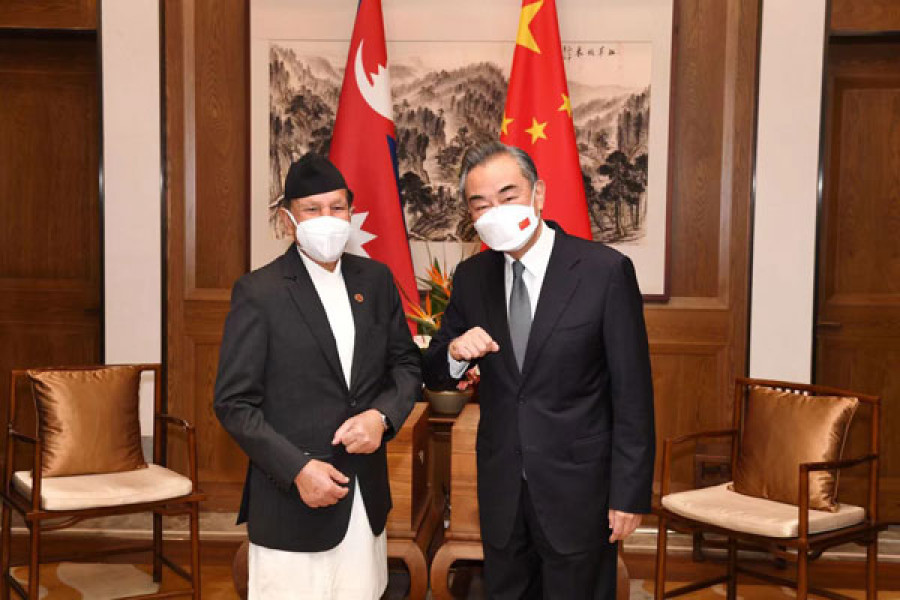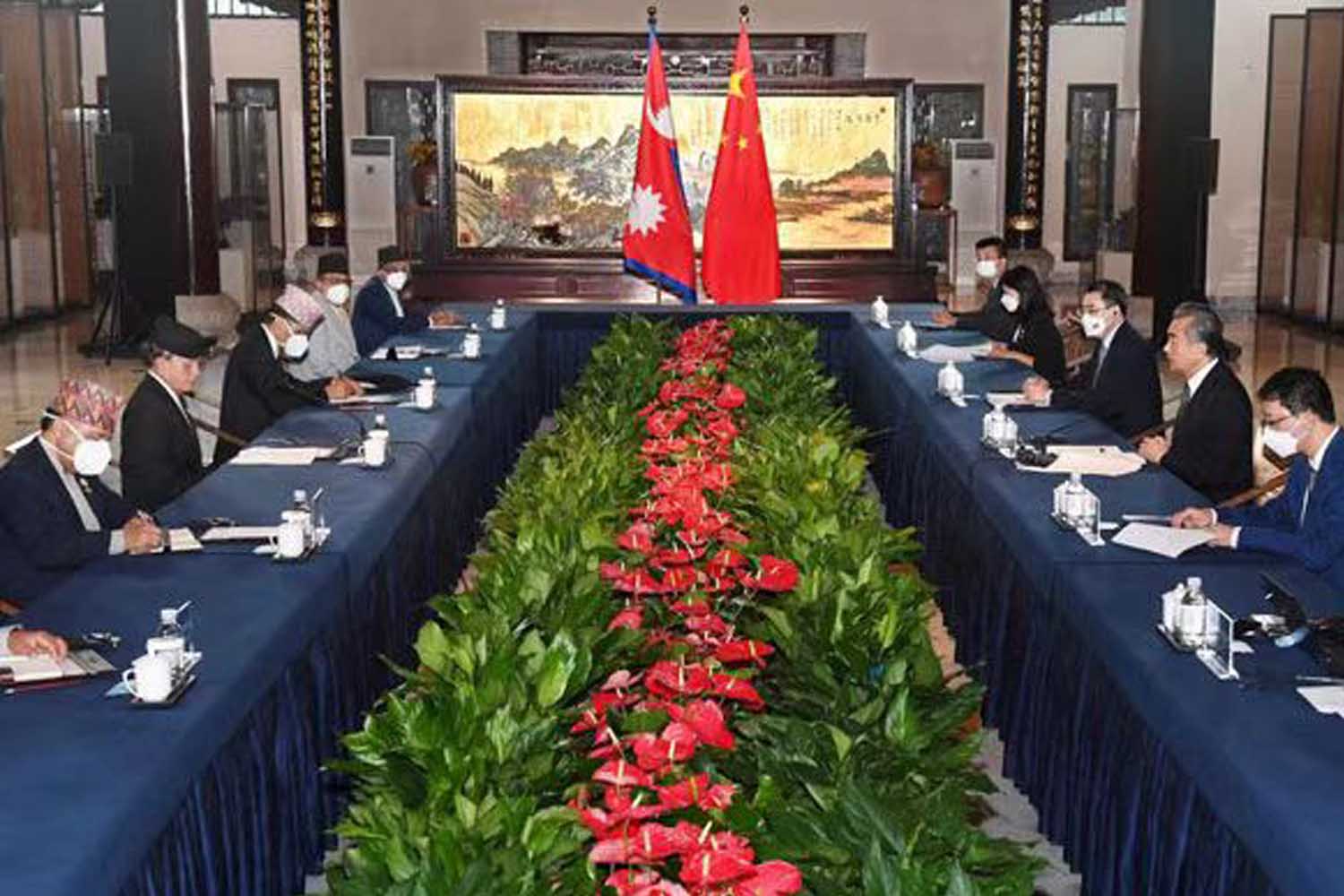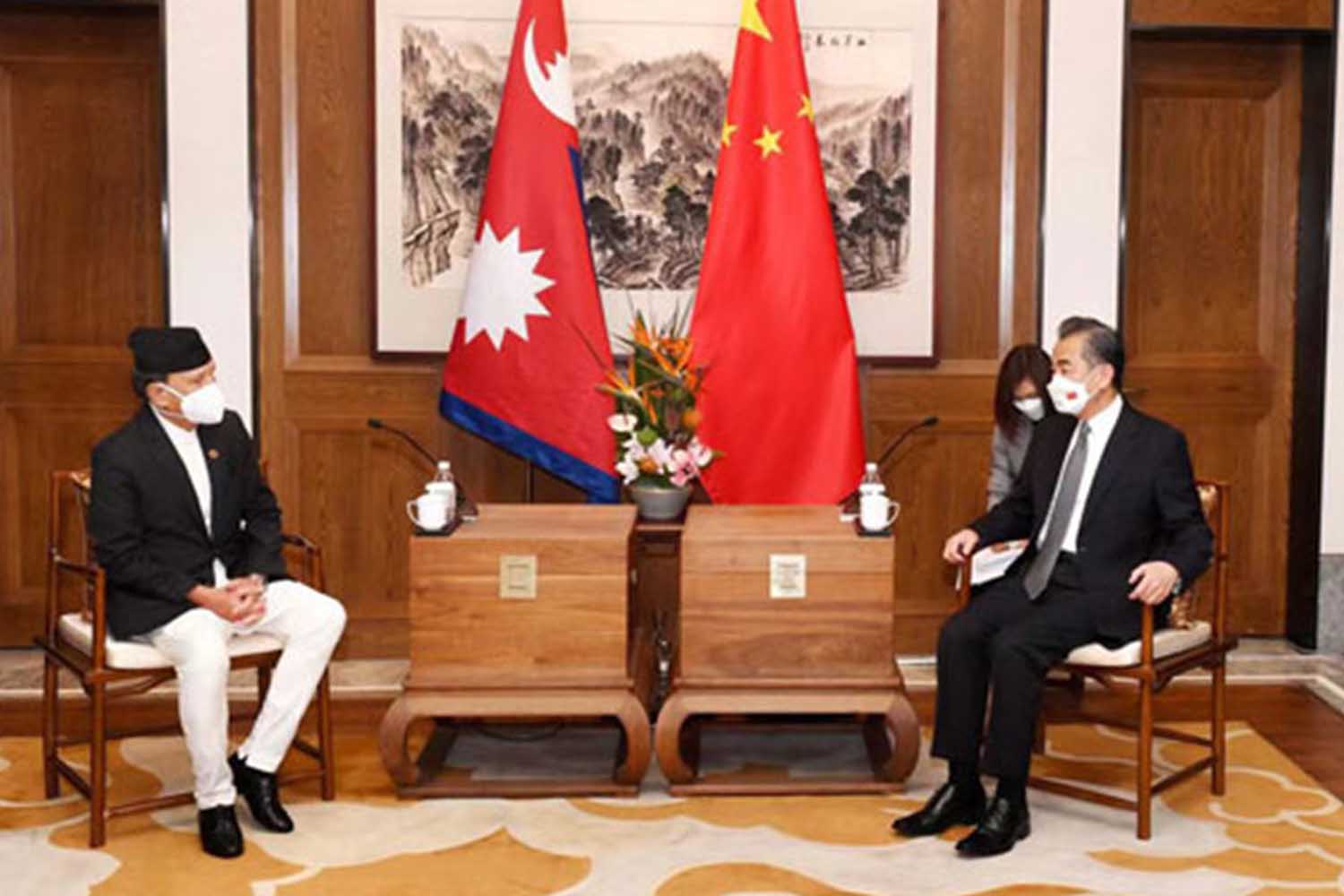
Foreign Minister Narayan Khadka returned home after completing his three-day visit to China on Thursday.
A slew of understandings were signed during Khadka’s meeting with his Chinese counterpart Wang Yi, who is also the state councillor of China.
After delegation-level talks between Khadka and Wang in Qingdao, both sides came up with separate statements late on Wednesday.
But there was a stark difference. Some points mentioned by the Chinese side in their statement were missing in the statement issued by Nepal’s embassy in Beijing—and vice versa.
One important takeaway of the visit is the announcement of 800 million RMB (Rs15 billion) grant assistance to Nepal for the year 2022. The economic assistance pledged by Wang during his meeting with Khadka is mentioned in the statement released by the Embassy of Nepal in Beijing, but there is no single word about it in the statement issued by the Chinese foreign ministry.
The Nepal statement is silent on the Belt and Road Initiative, an ambitious infrastructure project spanning several continents, which was initiated by Chinese President Xi Jinping in 2013.
Nepal signed up to the BRI in May 2017, but no single project has started under it here.
The statement issued by Beijing categorically mentions the BRI, saying the Chinese side is willing to work with Nepal for high-quality construction of the projects under the initiative.
“The two sides will negotiate and sign the implementation plan for the joint construction of the ‘Belt and Road’ as soon as possible,” reads the statement issued by the Chinese Foreign Ministry.
On Thursday afternoon, Chinese Ambassador to Nepal Hou Yanqi posted a tweet, particularly mentioning the BRI.
“The two sides reached broad consensus on bilateral cooperation including jointly uphold the ‘golden rule’ of non-interference in internal affairs and build the BRI with high quality,” Hou wrote on Twitter.

After delegation-level talks between Khadka and Wang in Qingdao, both sides came up with separate statements late on Wednesday. Photo via Ambassador Hou Yanqi/Twitter
The present establishment seems to have a paranoia with the letter “B” when it comes to China, a senior Foreign Ministry official said.
“The current dispensation does not want to discuss BRI in detail. We do not know the reason for this fear psychology among the current leadership in Kathmandu,” the official told the Post, seeking anonymity because he feared retribution. “We could have mentioned that projects under the BRI are in the consultation phase. We signed up to the BRI after national consensus so there was nothing to hide. If we try to hide such things, what kind of impression will the Chinese make about us?”
Earlier in March also when Wang visited Nepal, the statement issued by the Nepali side was silent on discussions on the BRI. But the Chinese side did mention it.
Pradeep Gyawali, a former foreign minister and CPN-UML leader, said that the incumbent Deuba government has taken a negative approach to the BRI since the beginning which could jeopardise Nepal’s credibility.
“Some people in the government think the BRI is about loans and even the prime minister is guided by this psychology,” said Gyawali. “The main issue is once we select the project and start negotiations, then the funding mechanism comes.”
Yet another issue that the Chinese mentioned but the Nepali side omitted is the Global Development Initiative (GDI) and the Global Security Initiative (GSI).
“Nepal agrees with the concept of the Global Development Initiative and the Global Security Initiative, and is willing to actively study and participate in the connection,” reads the Chinese statement.
Nepal did not mention the issue was discussed.
On the GSI, Nepali officials, however, have long expressed their reservations.
“China is trying to push us into the GSI. Due to our stated policy that Nepal does not take part in any security or military related alliance, there is no chance of agreeing to the GSI,” said the Foreign Ministry official who spoke on the condition of anonymity. “We may listen to their ideas and concepts but we will not be part of the GSI even if Western countries become its part.
The Foreign Ministry is also planning to raise the issue with the Chinese side over Beijing constantly linking Nepal with the GSI, according to the official.
In her opinion piece published in the Post on July 6 also, Hou, the Chinese ambassador, had mentioned GSI and Nepal.
“The Nepali side actively supports and responds to the Global Development and Security Initiative. China and Nepal share the same or similar views and propositions in adhering to the priority of development, the harmonious coexistence of man and nature, and the vision of common, comprehensive, cooperative and sustainable security,” she wrote.
China has not yet released the blueprint of the GSI, so there is no clarity on what it entails and how it works.
The GDI and the GSI are two different concepts forwarded by Beijing in September 2021 and April 2022, respectively, at the Boao Forum.
“We have supported the development initiative idea at the highest political level but neither has there been any proposal or discussion about the security initiative,” said another senior Foreign Ministry official. “We are not going to be a part of any security alliance which is our stated policy.
Binoj Basnyat, a retired Nepal Army major general, said that Nepal should be extra careful about joining any kind of security or military alliance, no matter who proposes it—the West or any other country.
“As far as the GSI is concerned, we don’t know how it works,” said Basnyat. “It seems to be China’s countermeasure against the West.”
Nepal recently saw a ruckus over the United States government’s State Partnership Program. Politicians across the political spectrum called on the government to reject Nepal’s participation in the SPP, saying it entails security and military components. Foreign Minister Khadka on July 29 told the House that Nepal wrote to the US on July 25 that it won’t become part of the SPP as per a June 21 government decision to that effect.
Khadka’s visit to the north took place just as US-China tensions reached a new high following the visit of US House Speaker Nancy Pelosi to Taiwan early this month. After Pelosi’s visit, China aggressively started seeking support to its claim over Taiwan and called for nations and organizations to support the one-China policy. Nepal’s Foreign Ministry stated that it is following the developments in the Taiwan Strait while committing to one-China policy.
“During the meeting, Foreign Minister Khadka reiterated Nepal’s unwavering commitment to the one-China China policy and assured that Nepali territory will not be allowed to be used for any activity against China,” reads the statement issued by the Nepali embassy in Beijing.
But the Chinese statement said more.

Foreign Minister Narayan Khadka with his Chinese counterpart Wang Yi in Qingdao. Photo via Ambassador Hou Yanqi/Twitter
“Khadka reiterated that Nepal firmly adheres to the one-China policy and will never allow the use of the Nepali territory to engage in any activities that oppose China and harm China's interests,” said the Chinese foreign ministry statement, “[Khadka said].. this firm commitment will never waver. Nepal supports China's legitimate position on internal affairs such as Tibet, Xinjiang and Hong Kong.”
“The Nepali side has always maintained that the UN Charter should be upheld, and believes that no country has the right to impose its will on others. Nepal adheres to the Five Principles of Peaceful Coexistence, especially the basic principles of respecting sovereignty and non-interference in each other's internal affairs, and will continue to stand firmly with China and safeguard and practice multilateralism,” the Chinese statement added.
After arriving in Kathmandu, Khadka told reporters that he assured Chinese officials that Nepali territory will not be used against China and reaffirmed Nepal’s firm commitment to the one-China policy.
Another Foreign Ministry official said that both sides issued statements for the consumption of their peoples.
When there is no joint statement, then each side wants to please their respective domestic constituencies, according to the official.
The statement issued by the Nepali side mentioned the opening of Hilsa-Pulang port for one way trade, claiming that it will resume as soon as the fresh wave of Covid-19 in the Tibet Autonomous Region of China is controlled. But the Chinese statement has no mention of it.
The Chinese statement is also silent on the opening of Rasuwa-Kerung and Tatopani-Khasa ports for two-way trade which Nepal has been looking at since the pandemic began.
Another important matter for Nepal during the talks was to revive the existing boundary mechanisms between Nepal and China in order to settle the border row. The bilateral mechanisms have been dormant since 2006.
The Nepali side has been continuously pushing for the revival of the existing boundary mechanisms at three different levels. Both sides agreed to resume talks during the virtual talks between senior officials last month.
“Both sides agreed to form a bilateral technical committee to do necessary preparation towards the functioning of the existing mechanism of Nepal-China Joint Boundary Inspection Committee,” said the Nepali statement.
However, the Chinese side is silent on it and has not mentioned a single word on the agreement.
“This was one of the crucial items on our agenda for the meeting,” one Nepali official who participated in the meeting told the Post. “However, it appears the issue was not a priority for them, and they must have refrained from mentioning it in their statement.”
Former officials who have handled several such bilateral visits said that in case both sides need to use separate statements, there is a general understanding about what to mention including what was agreed upon, what was signed, what was announced and what was discussed.
They say such different statements with crucial points missing have left them startled.
Yagya Bahadur Hamal, a former ambassador who retired last year as Foreign Ministry joint secretary, said that such a huge difference in the statements by the two countries after bilateral talks is quite unlikely as there’s usually some kind of understanding between two sides on what to mention or what not to mention.
“In the case of a joint statement, there’s no issue at all. But when the two sides come up with their separate statements, at least ahead of the visit or during the course of the meeting, officials from both sides do negotiate or exchange the text,” said Hamal. “Such prior communication between the two sides before releasing the statements is helpful in avoiding any misunderstanding.”
According to Hamal, the two sides issue statements to make public what they discuss, not to confuse the citizens.
“Bilateral talks are meant not only to strengthen ties between the two countries but also between the peoples,” said Hamal. “Different statements create confusion.”












